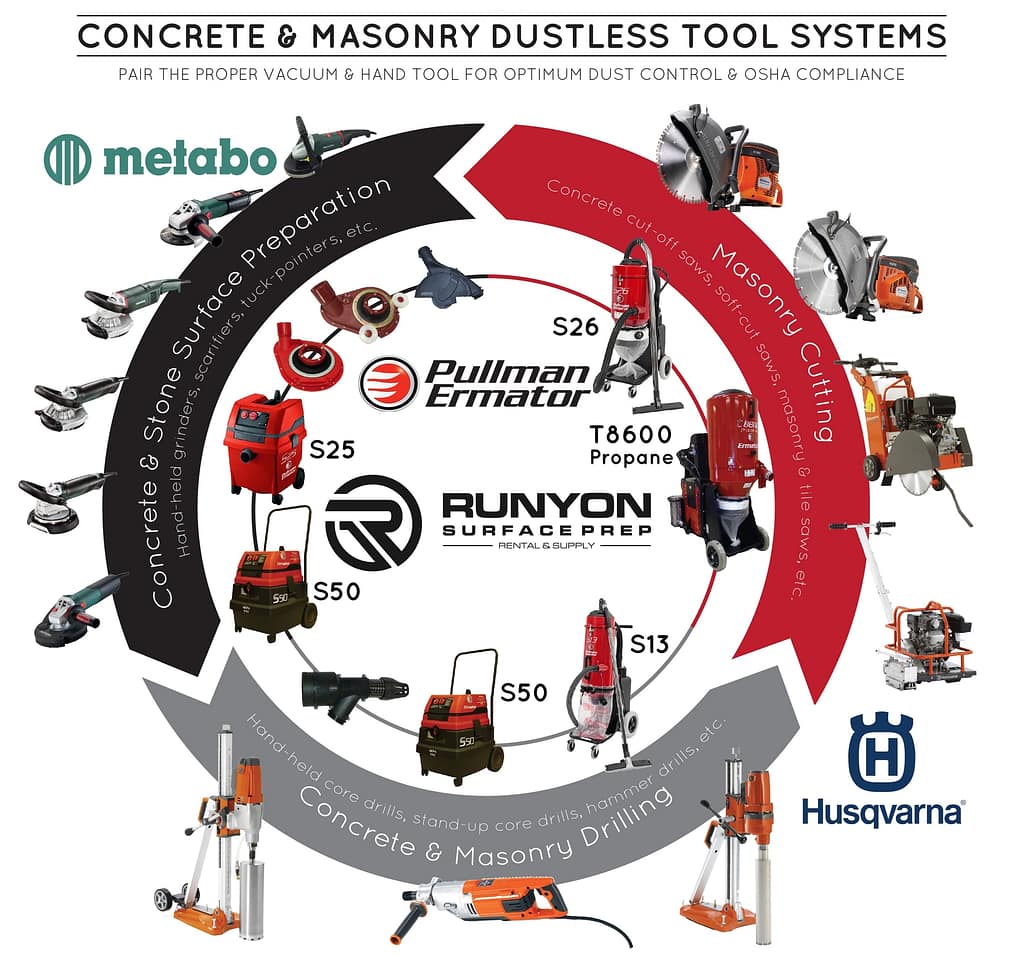As of June 23, 2016, a new OSHA regulation, Respirable crystalline silica, Section 29 CFR 1926.1153, is being implemented and enforced. This regulation builds upon the Occupational Safety and Health Administration’s National Emphasis Program on Crystalline Silica, which has been in effect since January 24, 2008. In addition to updating Permissible Exposure Limits (PELs), it sets forth stricter regulations on the contractor, demanding greater dust collection on the job site.
The Problem: Hazardous airborne dust in the industrial and construction industries.
The Solution: Engineered dust control through vacuums, air scrubbers and point-of-origin accessories.
“Equipment manufacturers, contractors and regulatory boards all need to work together to make work areas safer,” says Fredrik Akermark, VP of Sales and Marketing for Ermator USA. “With new PEL ratings for the construction industry, we all need to be pro-active in dust control.”

Dust Suppression in the Work Place
Contractors in all industries are now compelled to outfit tools and machines with dust containment equipment such as shrouds and vacuums. Manufactures of equipment in the concrete, masonry and stone industry are incorporating dust suppression systems into their equipment. These measures:
- Control airborne dust that is harmful to breathe
- Reduce labor on dust clean-up as it settles
- Protect workers at the job site
- Increase safety of employees and customers if the building is open during construction work
Hazards of Concrete Dust
Crystalline silica is a basic component of soil, sand, granite and many other minerals. Quartz is the most common form of crystalline silica, as well as Cristobalite and tridymite. All three may become respirable sized particles when workers chip, cut, drill or grind objects that contain crystalline silica. Crystalline silica has been classified as a human lung carcinogen and silica exposure remains a serious threat to nearly two million U.S. workers, including more than 100,000 workers in high risk jobs such as abrasive blasting, foundry work, concrete, rock and stone cutting, coring and drilling, quarry work and tunneling. Exposure can increase the risk of developing silicosis, lung cancer, tuberculosis and other debilitating diseases. The respirable silica dust enters the lungs and causes the formation of scar tissue, thus reducing the lungs’ ability to take in oxygen. Public health experts estimate that 280 workers die each year from silicosis – and thousands more develop silicosis as a result of workplace exposures. There is no cure for silicosis.
Features to Look for When Selecting a Vacuum
- High quality HEPA filters, that are tested and certified
- Multi levels of filtration that includes pre filters and pre separators
- Contained filter cleaning so as not to allow dust to escape when cleaning filters
- Proper Cubic Feet/Minute (CFM) and water lift for the tool its being attached to
- Accessory availability to install on the tool for collection at the source and floor tools for clean-up
- Auto tool features so as soon as the tool starts the dust control is activated
- Wet and dry availability when needed based on job site conditions
- Control of dust when changing bags with drop down systems

OSHA Recommendations
- Replace crystalline silica materials with safer substitutes, whenever possible.
- Provide engineering or administrative controls, where feasible, such as local exhaust ventilation, and blasting cabinets.
- Installing dust collection systems on to machines or equipment that generates dust
- Use all available work practices to control dust exposures, such as water sprays.
- Wear only a N95 NIOSH certified respirator, if respirator protection is required. Do not alter the respirator. Do not wear a tight-fitting respirator with a beard or mustache that prevents a good seal between the respirator and the face.
- Wear only a Type CE abrasive-blast supplied air respirator for abrasive blasting.
- Wear disposable or washable work clothes and shower if facilities are available. Vacuum the dust from your clothes or change into clean clothing before leaving the work site.
- Check filters hoses, shrouds and connectors when using dust control equipment to capture all particles from escaping.
- Participate in training, exposure monitoring, and health screening and surveillance programs to monitor any adverse health effects caused by crystalline silica exposures.
- Be aware of the operations and job tasks creating crystalline silica exposures in your workplace environment and know how to protect yourself.
- Use water attached to equipment to control dust.
- Be aware of the health hazards related to exposures to crystalline silica. Smoking adds to the lung damage caused by silica exposures.
- Do not eat, drink, smoke, or apply cosmetics in areas where crystalline silica dust is present. Wash your hands and face outside of dusty areas before performing any of these activities.
Pullman Ermator for New OSHA Regulation Compliance
Conventional vacuums don’t collect the hazardous silica dust to pass the new OSHA standards. Ermator dust extractors, air scrubbers and point-of-origin accessories help you comply in meeting OSHA’s new regulations. Ermator vacuums feature tested and certified HEPA filters, the highest CFM and waterlift in their class, Longopac collection system and mechanical JetPulse filter cleaning.
Runyon Surface Prep is a full service stocking distributor for all your concrete prep, polishing, decorative, repair, restoration and maintenance needs. We carry the full line of Ermator vacuums and pre-separators, as well as grinders, removal equipment, overlay products, color products, densifiers, mixers, diamond tooling, polyaspartics, joint fillers and much more. You name it, we have it!
